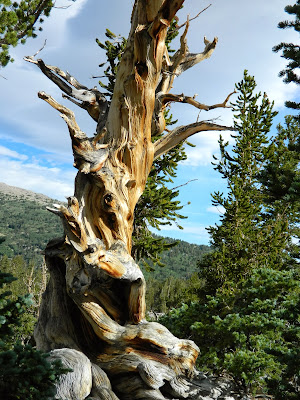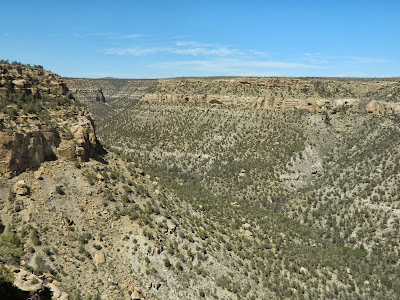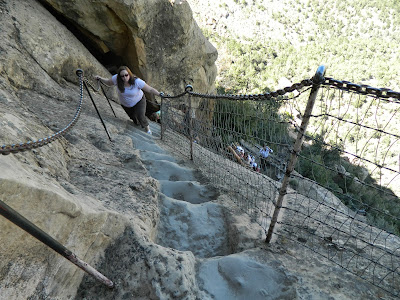[ACHTUNG!: There is a picture of an old motel bathroom with some truly lamentable 70s wallpaper in this post. It may make you feel bad. You have been warned.]
In my ongoing quest to visit as
many of the famous and not-so-famous sites in the general
Utah/Colorado/Idaho/Nevada/etc. area before I move out of the state at some
point in the indeterminate future…
Ok, I lost track of that
sentence. The point is that I’ve made a list of all the places I want to go,
and one of my goals is to get to all of the national parks in the region.
 |
| All the US national parks - notice how they're almost all in the western half of the country. (Map from: http://www.terragalleria.com/parks/parks-map.html) |
And that’s why I found myself
(with Aitch) driving towards Great Basin National Park—right across Utah’s western border
with Nevada—one fine (hot) Friday afternoon in August.
But who has ever heard of Great
Basin National Park?
Nobody, that’s who. In spite of
the fact that it’s only a few hours’ drive from Salt Lake City, St. George,
Moab, Capitol Reef, Bryce Canyon, and Zion, Great Basin is one of the ten least
visited national parks in the United States (most of the other least visited parks are in Alaska.)
Whereas Zion NP in Southern Utah receives nearly 3 million visitors a year, Great Basin receives
a measly 80,000. In fact, the park is so unknown that they don’t even charge
you a fee to get in.
A.
It’s in the Middle of Nowhere. Literally.
To get there, you drive a few hours into the Utah desert—and then you
keep on driving. And driving. It’s no coincidence that the main
road that runs past the park is nicknamed “the Loneliest Highway in America.”
B.
It’s just not that interesting compared to the
other parks in the area. It’s apparently a biologically important
area—herpetologists and botanists and biologists and phrenologists (?) and so on love it—but it
doesn’t have any of the “must-see” sites of most of the other parks in the
region.
Of course, the obscurity of the
park has its benefits—or so they say. For one, owing to the fact that the
nearest town of any size is more than a 100 miles away, it has some of the
darkest skies in the country. The dark skies apparently allow for some
really great stargazing.
Unfortunately, it was cloudy both
nights we were there so we missed out on that benefit.
Another benefit is that, if you
like solitude, this park has it in spades.
“Oh, we don’t allow reservations
because our campgrounds never fill up,” one of the Park Rangers
explained when we called a few weeks ahead of our trip.
Motels (and Other Horrors?)
Of course, the night we got there
all the campgrounds were completely full and we had to stay in a motel. A gross, stinking motel that looked like it hadn't received any upkeep (or had any of its decor/furniture replaced) since the 70s. I think I slept about two hours that night - because my bed made loud noises every time I moved and because motels are creepy.
 |
| Our motel room, since all the camp sites were full. |
 |
| Our motel room's bathroom. (Yes, I'm showing you all the ugly things before I show you the pretty things.) |
But anyways…
The park itself is actually nice.
As you’re driving towards it, it doesn’t look like much. But then you start
driving up a mountain—Wheeler Peak—and you pass flocks of wild turkeys looking
ridiculous as they cross the road and you can kind of see the appeal. Wheeler
Peak itself is quite distinctive and impressive (it’s the home to the only
glacier in the state of Nevada), and once you’re up there the sheer flatness
and vastness of the surrounding desert landscape is quite impressive (the top
of the Wheeler Peak Drive is at about 11,000 feet. The desert floor is about
4,000 feet.)
 |
| The view as we began to ascend Wheeler Peak Drive |
 |
| Wheeler Peak |
 |
| The view of Wheeler Peak from our campsite |
Lehman Caves and, also, a Lizard
So after the disappointment of
that first night (motels stink, literally), we were able to find a campground for the
next night and then take a tour of one of the park’s two main attractions: Lehman Caves.
The caves had lots of cool
features, but the very best feature was the temperature: A consistent 50
degrees Fahrenheit. The temperature at our campground was nice (and breezy),
since it was located at 11,000 feet—but the temperature in the desert wasn’t as
nice so the caves were a very pleasant break. It's hard to take good pictures in caves - at least my camera - so forgive the quality. You'll have to take my word for it that they were much more impressive in real life. (And cool. Did I mention that they were cool? As in pleasantly-not-hot?)
 |
| Lehman Caves |
-
The Bristlecones, and other Old Things
Sunday morning I took a hike up
from our campground to the second main attraction of the park (located at about
12,000 feet above sea level): The Bristlecone Pine Grove.
 |
| The trail up to the grove |
 |
| The slopes of Wheeler Peak are very rocky |
Bristlecone Pines are the oldest
known single living organisms in the world (there are some “clonal colonies”
that live longer by constantly cloning themselves, but they're cheaters so they don't count.*) [*Incidentally, one of the largest "clonal colonies" in the world - a grove of quaking aspens that's supposed to be about a million years old - is located in central Utah. I'm already planning to visit it next year.]
These things are old. Some of
them are nearly 5,000 years old. When the pyramids of Giza were being built,
some of these things were already 500 years old. When Alexander the Great
conquered the known world, some of these trees were already 2500 years old.
 |
| I like how someone scratched out the word "grotesque" |
 |
| The sign says that this tree is more than 3200 years old - and that it required five core samples from the tree to get a complete sequence of its growth rings. |
These things are old.
And the hike up to them was very beautiful,
and satisfying (note to self: Go on more hikes.) There was something very
peaceful (and even comforting) about standing near the top of a mountain in
this grove of ancient organisms.
And Glaciers!
Anyways…
Since I had already hiked a few
miles to see the trees, I decided to go just a little bit farther (and a little
bit higher) to see the Wheeler Park Glacier. Which, as it turns out, is just a
tiny patch of dirty snow.
But, hey! Glacier!
 |
| The trail past the Bristlecone Grove, towards the glacier |
 |
| See that tiny patch of snow? Yeah, that's the glacier. |
 |
| A close-up of the "glacier." To be fair, I was there in August - when it's probably as its smallest. |
 |
| An Alpine "lake" on my way back down the mountain |
 |
| At the bottom of the trail |
And...
If you can only visit five
national parks within a five-hour drive of Salt Lake City, Great Basin doesn’t
need to be one of them. However, if you live in the area—or if you happen to be
driving from, say, California to Utah—it might be worth the detour. But it’s
one of those parks where you have to get out of your car and hike a bit to
really appreciate—so only go if you know you can get tickets to the caves and
if you’re ready to take the fairly strenuous Bristlecone Pike Hike.
...And back across the desert we go.
 |
| A crazy person |
 |
| Sevier Lake in Utah's west desert - it's huge and it looks like it has water, but it's almost always bone dry |


































